steering FIAT DUCATO BASE CAMPER 2017 Owner handbook (in English)
[x] Cancel search | Manufacturer: FIAT, Model Year: 2017, Model line: DUCATO BASE CAMPER, Model: FIAT DUCATO BASE CAMPER 2017Pages: 296, PDF Size: 14.44 MB
Page 199 of 296
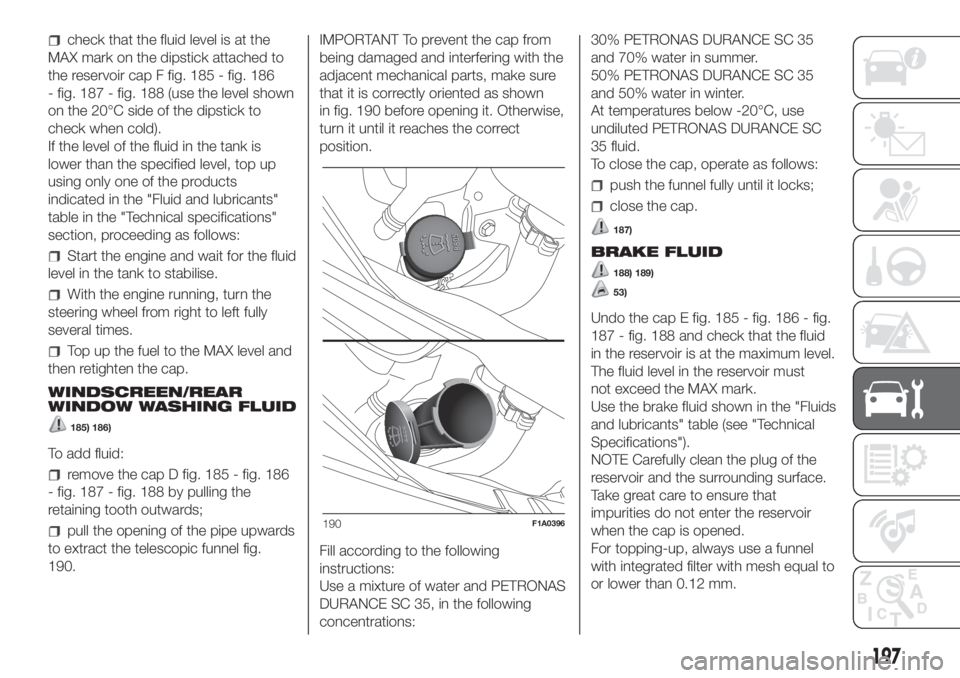
check that the fluid level is at the
MAX mark on the dipstick attached to
the reservoir cap F fig. 185 - fig. 186
- fig. 187 - fig. 188 (use the level shown
on the 20°C side of the dipstick to
check when cold).
If the level of the fluid in the tank is
lower than the specified level, top up
using only one of the products
indicated in the "Fluid and lubricants"
table in the "Technical specifications"
section, proceeding as follows:
Start the engine and wait for the fluid
level in the tank to stabilise.
With the engine running, turn the
steering wheel from right to left fully
several times.
Top up the fuel to the MAX level and
then retighten the cap.
WINDSCREEN/REAR
WINDOW WASHING FLUID
185) 186)
To add fluid:
remove the cap D fig. 185 - fig. 186
- fig. 187 - fig. 188 by pulling the
retaining tooth outwards;
pull the opening of the pipe upwards
to extract the telescopic funnel fig.
190.IMPORTANT To prevent the cap from
being damaged and interfering with the
adjacent mechanical parts, make sure
that it is correctly oriented as shown
in fig. 190 before opening it. Otherwise,
turn it until it reaches the correct
position.
Fill according to the following
instructions:
Use a mixture of water and PETRONAS
DURANCE SC 35, in the following
concentrations:30% PETRONAS DURANCE SC 35
and 70% water in summer.
50% PETRONAS DURANCE SC 35
and 50% water in winter.
At temperatures below -20°C, use
undiluted PETRONAS DURANCE SC
35 fluid.
To close the cap, operate as follows:
push the funnel fully until it locks;
close the cap.
187)
BRAKE FLUID
188) 189)
53)
Undo the cap E fig. 185 - fig. 186 - fig.
187 - fig. 188 and check that the fluid
in the reservoir is at the maximum level.
The fluid level in the reservoir must
not exceed the MAX mark.
Use the brake fluid shown in the "Fluids
and lubricants" table (see "Technical
Specifications").
NOTE Carefully clean the plug of the
reservoir and the surrounding surface.
Take great care to ensure that
impurities do not enter the reservoir
when the cap is opened.
For topping-up, always use a funnel
with integrated filter with mesh equal to
or lower than 0.12 mm.
190F1A0396
197
Page 200 of 296
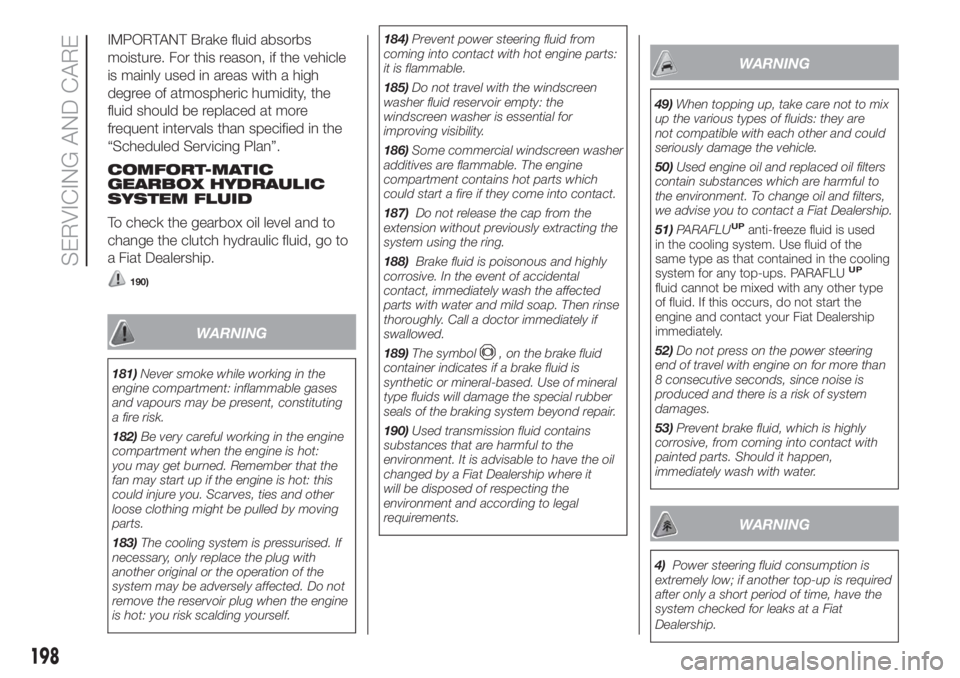
IMPORTANT Brake fluid absorbs
moisture. For this reason, if the vehicle
is mainly used in areas with a high
degree of atmospheric humidity, the
fluid should be replaced at more
frequent intervals than specified in the
“Scheduled Servicing Plan”.
COMFORT-MATIC
GEARBOX HYDRAULIC
SYSTEM FLUID
To check the gearbox oil level and to
change the clutch hydraulic fluid, go to
a Fiat Dealership.
190)
WARNING
181)Never smoke while working in the
engine compartment: inflammable gases
and vapours may be present, constituting
a fire risk.
182)Be very careful working in the engine
compartment when the engine is hot:
you may get burned. Remember that the
fan may start up if the engine is hot: this
could injure you. Scarves, ties and other
loose clothing might be pulled by moving
parts.
183)The cooling system is pressurised. If
necessary, only replace the plug with
another original or the operation of the
system may be adversely affected. Do not
remove the reservoir plug when the engine
is hot: you risk scalding yourself.184)Prevent power steering fluid from
coming into contact with hot engine parts:
it is flammable.
185)Do not travel with the windscreen
washer fluid reservoir empty: the
windscreen washer is essential for
improving visibility.
186)Some commercial windscreen washer
additives are flammable. The engine
compartment contains hot parts which
could start a fire if they come into contact.
187)Do not release the cap from the
extension without previously extracting the
system using the ring.
188)Brake fluid is poisonous and highly
corrosive. In the event of accidental
contact, immediately wash the affected
parts with water and mild soap. Then rinse
thoroughly. Call a doctor immediately if
swallowed.
189)The symbol
, on the brake fluid
container indicates if a brake fluid is
synthetic or mineralbased. Use of mineral
type fluids will damage the special rubber
seals of the braking system beyond repair.
190)Used transmission fluid contains
substances that are harmful to the
environment. It is advisable to have the oil
changed by a Fiat Dealership where it
will be disposed of respecting the
environment and according to legal
requirements.
WARNING
49)When topping up, take care not to mix
up the various types of fluids: they are
not compatible with each other and could
seriously damage the vehicle.
50)Used engine oil and replaced oil filters
contain substances which are harmful to
the environment. To change oil and filters,
we advise you to contact a Fiat Dealership.
51)PARAFLU
UPanti-freeze fluid is used
in the cooling system. Use fluid of the
same type as that contained in the cooling
system for any top-ups. PARAFLU
UP
fluid cannot be mixed with any other type
of fluid. If this occurs, do not start the
engine and contact your Fiat Dealership
immediately.
52)Do not press on the power steering
end of travel with engine on for more than
8 consecutive seconds, since noise is
produced and there is a risk of system
damages.
53)Prevent brake fluid, which is highly
corrosive, from coming into contact with
painted parts. Should it happen,
immediately wash with water.
WARNING
4)Power steering fluid consumption is
extremely low; if another top-up is required
after only a short period of time, have the
system checked for leaks at a Fiat
Dealership.
198
SERVICING AND CARE
Page 205 of 296
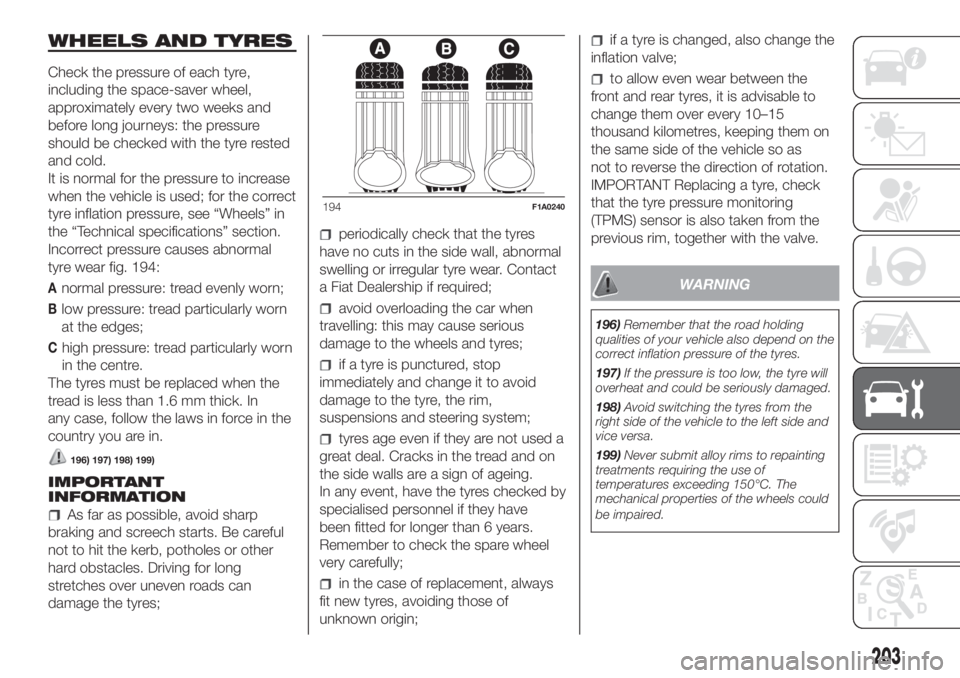
WHEELS AND TYRES
Check the pressure of each tyre,
including the space-saver wheel,
approximately every two weeks and
before long journeys: the pressure
should be checked with the tyre rested
and cold.
It is normal for the pressure to increase
when the vehicle is used; for the correct
tyre inflation pressure, see “Wheels” in
the “Technical specifications” section.
Incorrect pressure causes abnormal
tyre wear fig. 194:
Anormal pressure: tread evenly worn;
Blow pressure: tread particularly worn
at the edges;
Chigh pressure: tread particularly worn
in the centre.
The tyres must be replaced when the
tread is less than 1.6 mm thick. In
any case, follow the laws in force in the
country you are in.
196) 197) 198) 199)
IMPORTANT
INFORMATION
As far as possible, avoid sharp
braking and screech starts. Be careful
not to hit the kerb, potholes or other
hard obstacles. Driving for long
stretches over uneven roads can
damage the tyres;
periodically check that the tyres
have no cuts in the side wall, abnormal
swelling or irregular tyre wear. Contact
a Fiat Dealership if required;
avoid overloading the car when
travelling: this may cause serious
damage to the wheels and tyres;
if a tyre is punctured, stop
immediately and change it to avoid
damage to the tyre, the rim,
suspensions and steering system;
tyres age even if they are not used a
great deal. Cracks in the tread and on
the side walls are a sign of ageing.
In any event, have the tyres checked by
specialised personnel if they have
been fitted for longer than 6 years.
Remember to check the spare wheel
very carefully;
in the case of replacement, always
fit new tyres, avoiding those of
unknown origin;
if a tyre is changed, also change the
inflation valve;
to allow even wear between the
front and rear tyres, it is advisable to
change them over every 10–15
thousand kilometres, keeping them on
the same side of the vehicle so as
not to reverse the direction of rotation.
IMPORTANT Replacing a tyre, check
that the tyre pressure monitoring
(TPMS) sensor is also taken from the
previous rim, together with the valve.
WARNING
196)Remember that the road holding
qualities of your vehicle also depend on the
correct inflation pressure of the tyres.
197)If the pressure is too low, the tyre will
overheat and could be seriously damaged.
198)Avoid switching the tyres from the
right side of the vehicle to the left side and
vice versa.
199)Never submit alloy rims to repainting
treatments requiring the use of
temperatures exceeding 150°C. The
mechanical properties of the wheels could
be impaired.
194F1A0240
203
Page 208 of 296
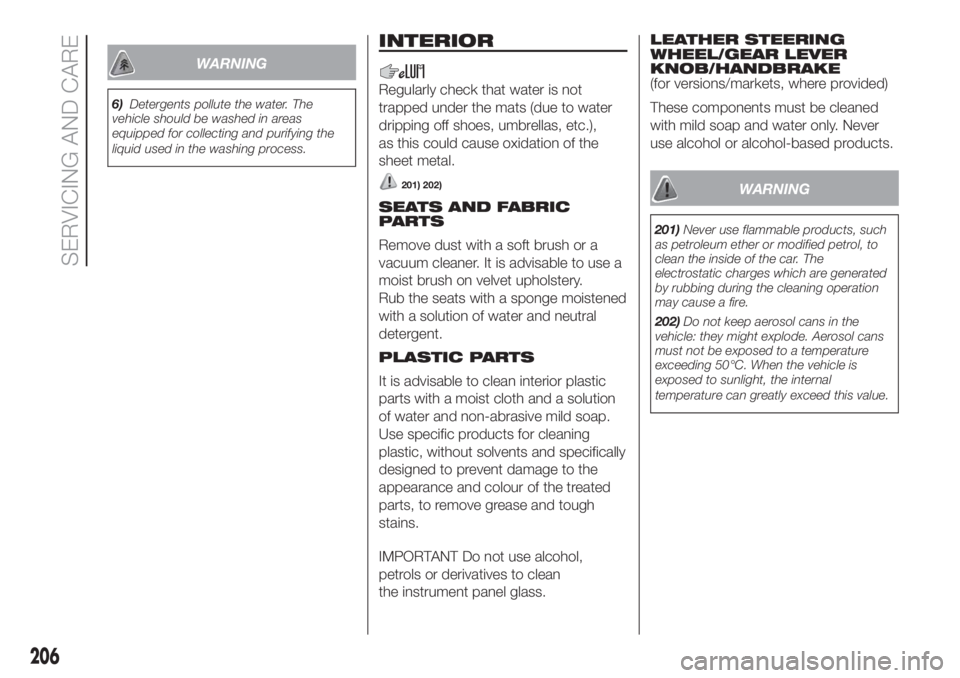
WARNING
6)Detergents pollute the water. The
vehicle should be washed in areas
equipped for collecting and purifying the
liquid used in the washing process.
INTERIOR
Regularly check that water is not
trapped under the mats (due to water
dripping off shoes, umbrellas, etc.),
as this could cause oxidation of the
sheet metal.
201) 202)
SEATS AND FABRIC
PARTS
Remove dust with a soft brush or a
vacuum cleaner. It is advisable to use a
moist brush on velvet upholstery.
Rub the seats with a sponge moistened
with a solution of water and neutral
detergent.
PLASTIC PARTS
It is advisable to clean interior plastic
parts with a moist cloth and a solution
of water and non-abrasive mild soap.
Use specific products for cleaning
plastic, without solvents and specifically
designed to prevent damage to the
appearance and colour of the treated
parts, to remove grease and tough
stains.
IMPORTANT Do not use alcohol,
petrols or derivatives to clean
the instrument panel glass.LEATHER STEERING
WHEEL/GEAR LEVER
KNOB/HANDBRAKE
(for versions/markets, where provided)
These components must be cleaned
with mild soap and water only. Never
use alcohol or alcohol-based products.
WARNING
201)Never use flammable products, such
as petroleum ether or modified petrol, to
clean the inside of the car. The
electrostatic charges which are generated
by rubbing during the cleaning operation
may cause a fire.
202)Do not keep aerosol cans in the
vehicle: they might explode. Aerosol cans
must not be exposed to a temperature
exceeding 50°C. When the vehicle is
exposed to sunlight, the internal
temperature can greatly exceed this value.
206
SERVICING AND CARE
Page 210 of 296
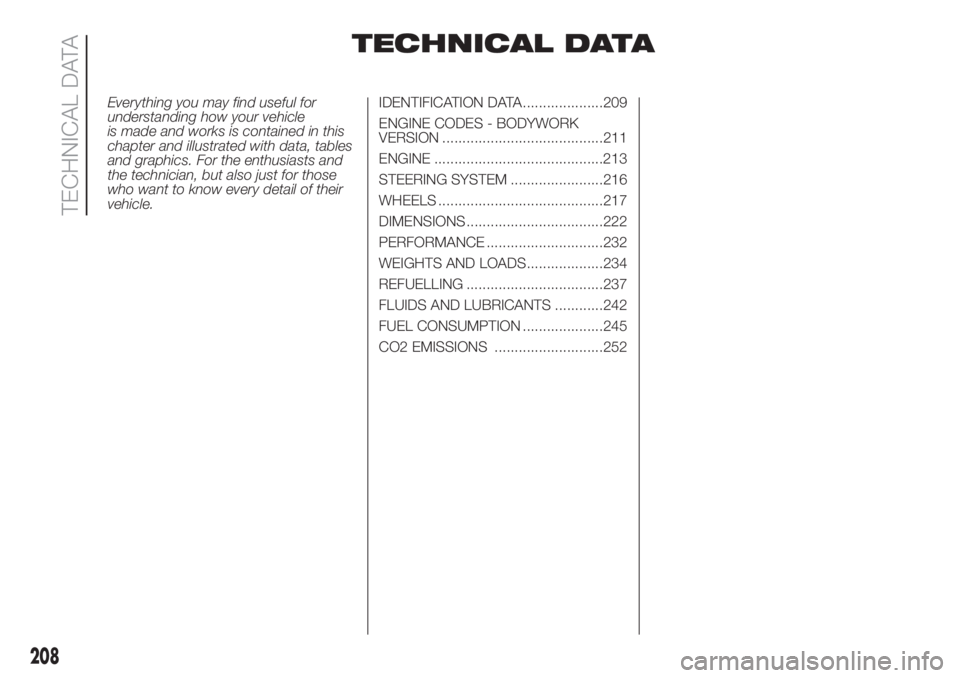
TECHNICAL DATA
Everything you may find useful for
understanding how your vehicle
is made and works is contained in this
chapter and illustrated with data, tables
and graphics. For the enthusiasts and
the technician, but also just for those
who want to know every detail of their
vehicle.IDENTIFICATION DATA....................209
ENGINE CODES - BODYWORK
VERSION ........................................211
ENGINE ..........................................213
STEERING SYSTEM .......................216
WHEELS .........................................217
DIMENSIONS ..................................222
PERFORMANCE .............................232
WEIGHTS AND LOADS...................234
REFUELLING ..................................237
FLUIDS AND LUBRICANTS ............242
FUEL CONSUMPTION ....................245
CO2 EMISSIONS ...........................252
208
TECHNICAL DATA
Page 218 of 296
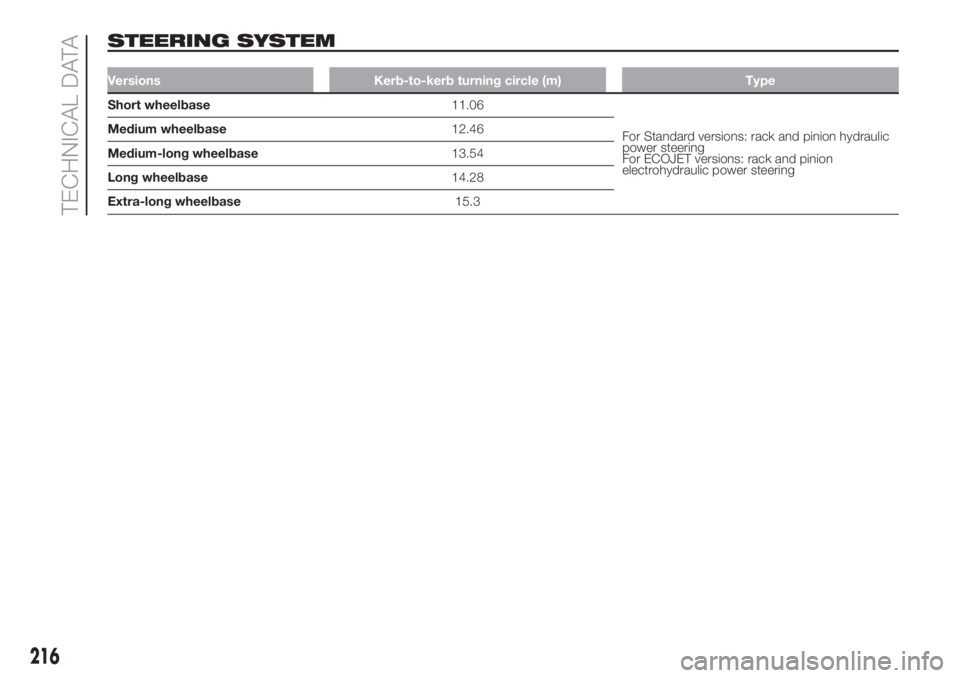
STEERING SYSTEM
Versions Kerb-to-kerb turning circle (m) Type
Short wheelbase11.06
For Standard versions: rack and pinion hydraulic
power steering
For ECOJET versions: rack and pinion
electrohydraulic power steering Medium wheelbase12.46
Medium-long wheelbase13.54
Long wheelbase14.28
Extra-long wheelbase15.3
216
TECHNICAL DATA
Page 241 of 296
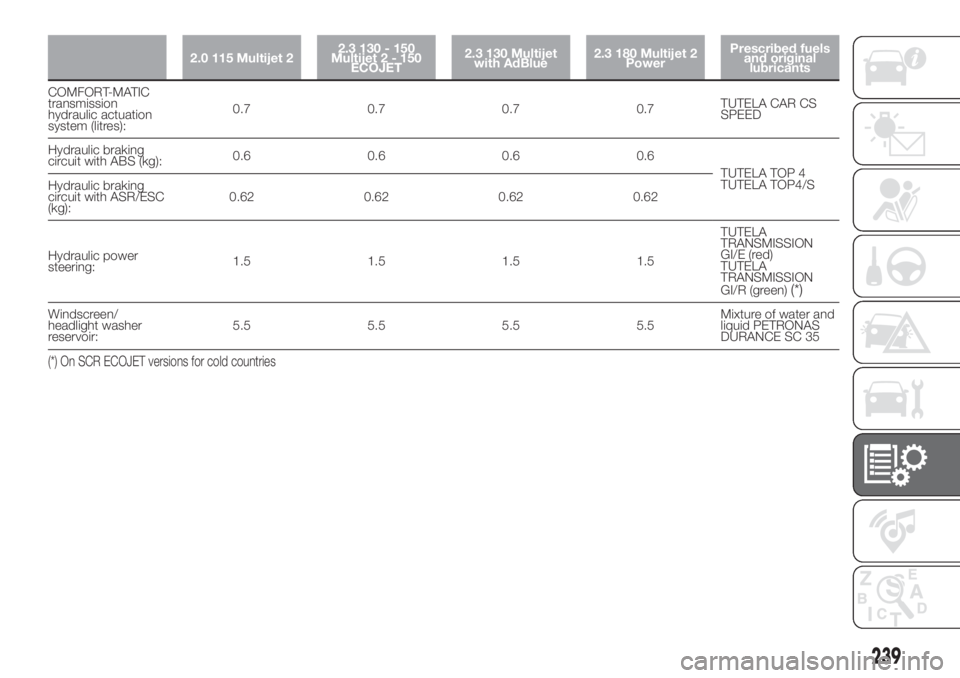
2.0 115 Multijet 22.3 130 - 150
Multijet2-150
ECOJET2.3 130 Multijet
with AdBlue2.3 180 Multijet 2
PowerPrescribed fuels
and original
lubricants
COMFORT-MATIC
transmission
hydraulic actuation
system (litres):0.7 0.7 0.7 0.7TUTELA CAR CS
SPEED
Hydraulic braking
circuit with ABS (kg):0.6 0.6 0.6 0.6
TUTELA TOP 4
TUTELA TOP4/S
Hydraulic braking
circuit with ASR/ESC
(kg):0.62 0.62 0.62 0.62
Hydraulic power
steering:1.5 1.5 1.5 1.5TUTELA
TRANSMISSION
GI/E (red)
TUTELA
TRANSMISSION
GI/R (green)
(*)
Windscreen/
headlight washer
reservoir:5.5 5.5 5.5 5.5Mixture of water and
liquid PETRONAS
DURANCE SC 35
(*) On SCR ECOJET versions for cold countries
239
Page 242 of 296
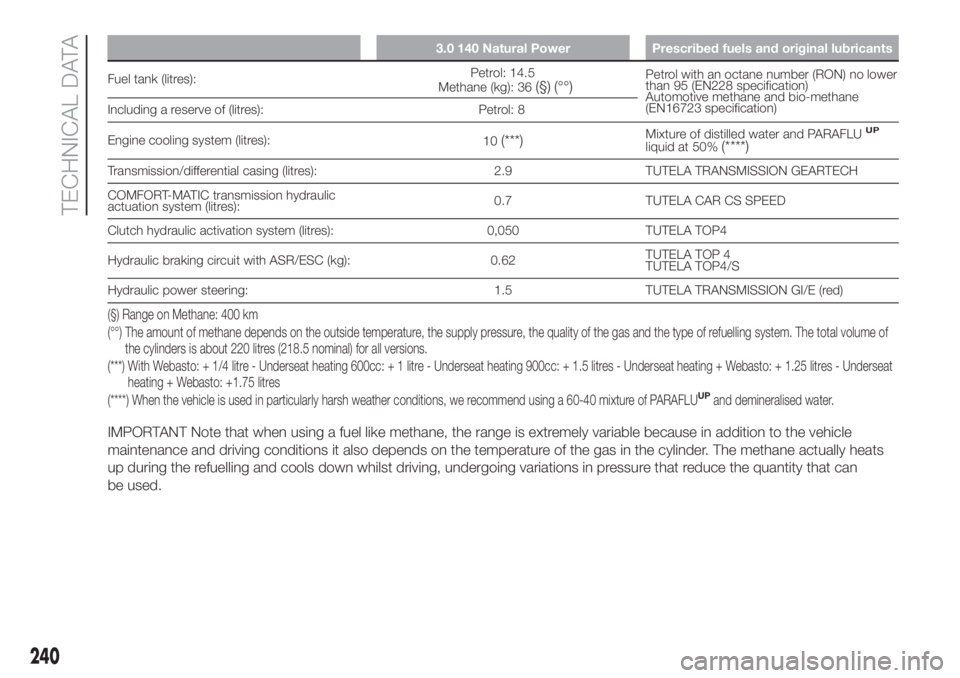
3.0 140 Natural Power Prescribed fuels and original lubricants
Fuel tank (litres):Petrol: 14.5
Methane (kg): 36(§) (°°)Petrol with an octane number (RON) no lower
than 95 (EN228 specification)
Automotive methane and bio-methane
(EN16723 specification)
Including a reserve of (litres): Petrol: 8
Engine cooling system (litres):
10
(***)Mixture of distilled water and PARAFLUUP
liquid at 50%(****)
Transmission/differential casing (litres): 2.9 TUTELA TRANSMISSION GEARTECH
COMFORT-MATIC transmission hydraulic
actuation system (litres):0.7 TUTELA CAR CS SPEED
Clutch hydraulic activation system (litres): 0,050 TUTELA TOP4
Hydraulic braking circuit with ASR/ESC (kg): 0.62TUTELA TOP 4
TUTELA TOP4/S
Hydraulic power steering: 1.5 TUTELA TRANSMISSION GI/E (red)
(§) Range on Methane: 400 km
(°°) The amount of methane depends on the outside temperature, the supply pressure, the quality of the gas and the type of refuelling system. The total volume of
the cylinders is about 220 litres (218.5 nominal) for all versions.
(***) With Webasto: + 1/4 litre - Underseat heating 600cc: + 1 litre - Underseat heating 900cc: + 1.5 litres - Underseat heating + Webasto: + 1.25 litres - Underseat
heating + Webasto: +1.75 litres
(****) When the vehicle is used in particularly harsh weather conditions, we recommend using a 60-40 mixture of PARAFLU
UPand demineralised water.
IMPORTANT Note that when using a fuel like methane, the range is extremely variable because in addition to the vehicle
maintenance and driving conditions it also depends on the temperature of the gas in the cylinder. The methane actually heats
up during the refuelling and cools down whilst driving, undergoing variations in pressure that reduce the quantity that can
be used.
240
TECHNICAL DATA
Page 245 of 296
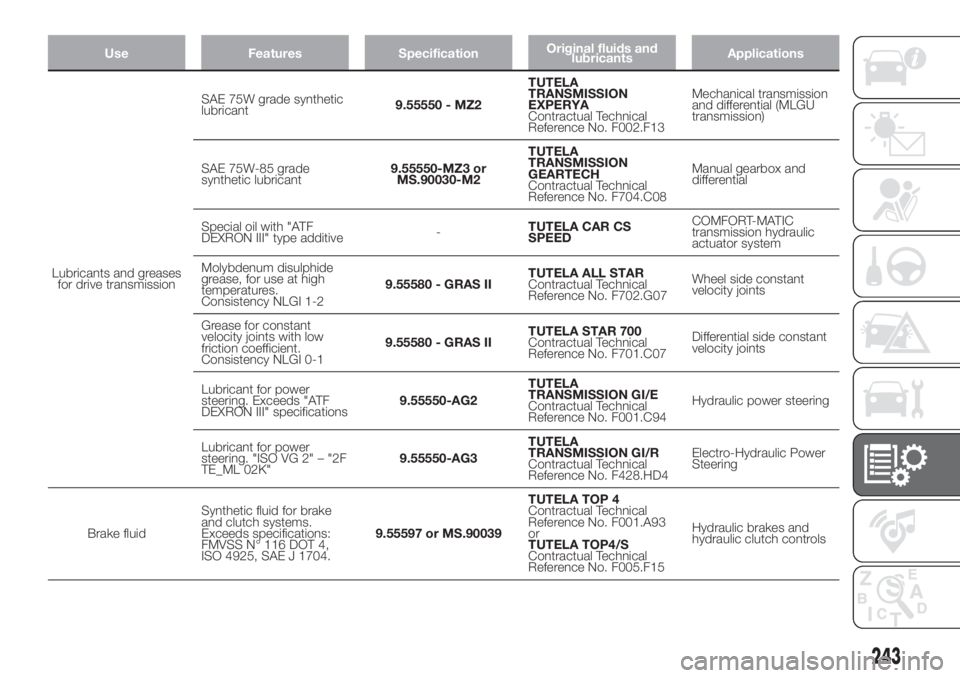
Use Features SpecificationOriginal fluids and
lubricantsApplications
Lubricants and greases
for drive transmissionSAE 75W grade synthetic
lubricant9.55550 - MZ2TUTELA
TRANSMISSION
EXPERYA
Contractual Technical
Reference No. F002.F13Mechanical transmission
and differential (MLGU
transmission)
SAE 75W-85 grade
synthetic lubricant9.55550-MZ3 or
MS.90030-M2TUTELA
TRANSMISSION
GEARTECH
Contractual Technical
Reference No. F704.C08Manual gearbox and
differential
Special oil with "ATF
DEXRON III" type additive-TUTELA CAR CS
SPEEDCOMFORT-MATIC
transmission hydraulic
actuator system
Molybdenum disulphide
grease, for use at high
temperatures.
Consistency NLGI 1-29.55580 - GRAS IITUTELA ALL STAR
Contractual Technical
Reference No. F702.G07Wheel side constant
velocity joints
Grease for constant
velocity joints with low
friction coefficient.
Consistency NLGI 0-19.55580 - GRAS IITUTELA STAR 700
Contractual Technical
Reference No. F701.C07Differential side constant
velocity joints
Lubricant for power
steering. Exceeds "ATF
DEXRON III" specifications9.55550-AG2TUTELA
TRANSMISSION GI/E
Contractual Technical
Reference No. F001.C94Hydraulic power steering
Lubricant for power
steering. "ISO VG 2" – "2F
TE_ML 02K"9.55550-AG3TUTELA
TRANSMISSION GI/R
Contractual Technical
Reference No. F428.HD4Electro-Hydraulic Power
Steering
Brake fluidSynthetic fluid for brake
and clutch systems.
Exceeds specifications:
FMVSS N° 116 DOT 4,
ISO 4925, SAE J 1704.9.55597 or MS.90039TUTELA TOP 4
Contractual Technical
Reference No. F001.A93
or
TUTELA TOP4/S
Contractual Technical
Reference No. F005.F15Hydraulic brakes and
hydraulic clutch controls
243
Page 268 of 296
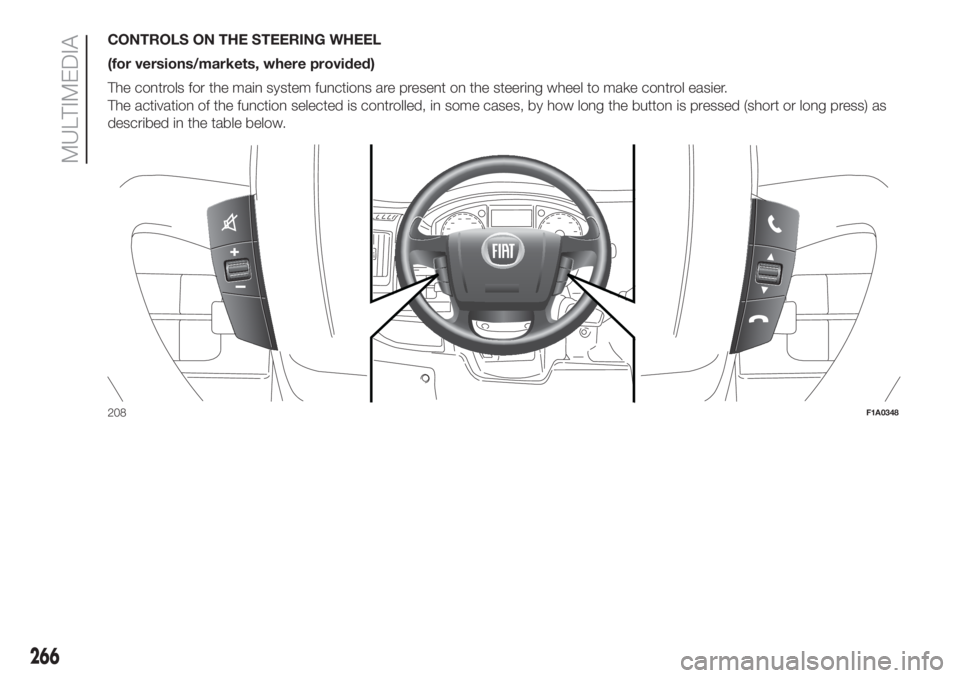
CONTROLS ON THE STEERING WHEEL
(for versions/markets, where provided)
The controls for the main system functions are present on the steering wheel to make control easier.
The activation of the function selected is controlled, in some cases, by how long the button is pressed (short or long press) as
described in the table below.
208F1A0348
266
MULTIMEDIA